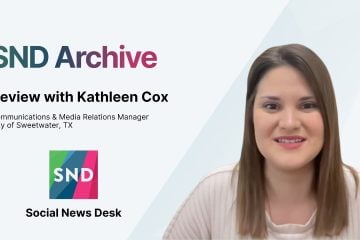In government, public safety, education, and other high-stakes environments, posting to social media is just the beginning. Every update, alert, or announcement is part of a bigger picture — one that spans from the first brainstorming session to long-term archiving. During Social News Desk’s webinar “You Posted It – Now What? Creating a Lifecycle for Social Media Content,” Sarah Loyd, Head of Product Success & Evangelism, and Angela Schutzman, Sales Manager, shared a practical, five-stage framework for building consistency, compliance, and accountability into your social media communications.
Stage 1: Planning & Drafting
Good planning prevents last-minute chaos and ensures consistent messaging.
Best practices:
– Use a shared content calendar to coordinate post dates, themes, and key events.
– Color-code or tag posts by department, topic, or tone (e.g., urgent, celebratory, informational).
– Document objectives — Who’s the audience? What’s the goal? What’s the tone?
– Plan for platform nuances like image sizes, thread formats, and character counts.
– Assign priority levels to distinguish between evergreen, timely, and emergency content.
Stage 2: Internal Review & Approval
Structured approvals reduce errors and compliance risks without slowing things down.
Key tips:
– Match review depth to content type — urgent posts may need fewer steps, while policy statements require senior or legal sign-off.
– Define roles clearly (content owners, leadership, legal/compliance, accessibility reviewer, final approver).
– Use structured workflows instead of email or chat (Google Docs, project management tools, or platforms like Social News Desk with built-in approvals).
– Prepare pre-approved templates for emergencies to speed response.
Stage 3: Scheduling & Publishing
Centralized scheduling keeps teams aligned and records intact.
What to track:
– Post date and time
– Publishing user and account
– Final content (text, links, media, tags)
Using a social media management tool ensures transparency, prevents duplicate efforts, and simplifies pausing posts during sensitive events. Always run a quick pre-publish checklist to confirm accuracy, accessibility, and timing.
Stage 4: Engagement & Community Management
Engagement means more than likes — it’s about connection, clarity, and responsiveness.
Pro tips:
– Set up a rotation for monitoring comments and DMs.
– Post or link to a commenting policy so expectations are clear.
– Prioritize questions from residents, parents, and stakeholders.
– Keep tone professional and empathetic, even in criticism.
– Archive all public interactions (including deleted or edited comments) as part of the official record.
– Escalate threats or urgent issues promptly and document all responses.
Stage 5: Retention, Archiving & Deletion
For government and public schools, every post is an official record — and so are the replies, edits, and deletions.
Retention tips:
– Follow state/local records schedules — retention can range from months to permanent.
– Use an automated archiving tool like SND Archive to capture posts, comments, edits, and metadata.
– Ensure archives are secure, searchable, and exportable.
– If deleting content, archive it first and document the reason.
– Train your team on what qualifies as a record and how to respond to records requests.
Why the Lifecycle Matters
Without a documented process, you risk lost records, compliance gaps, and confusion over responsibilities. With a clear lifecycle, you gain efficiency, reduce risk, and build public trust. Whether you manage a small-town communications office or a large university social team, these five stages give you a repeatable, scalable framework for social media management — one that keeps your messaging on point and your records audit-ready.
Want to streamline your own social media lifecycle? Start a free trial of Social News Desk at www.socialnewsdesk.com/demo or explore SND Archive to see how automation can simplify your compliance and record keeping.




